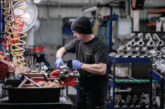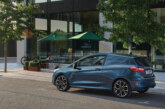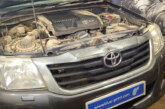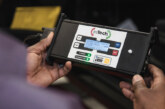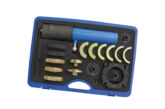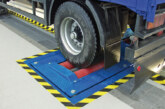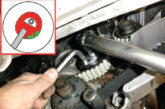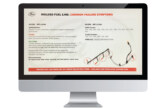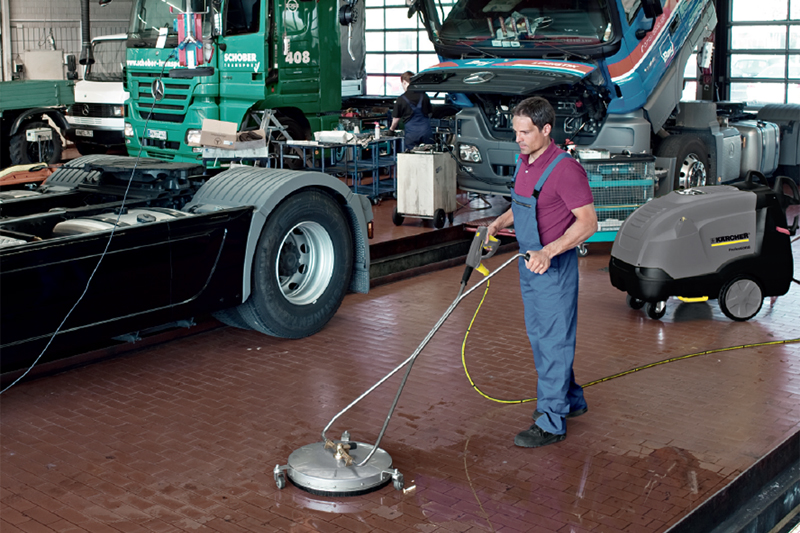
Daniel Took, Head of Professional Product Marketing at Karcher UK, shares expert knowledge and cleaning advice to keep LCV fleets spotless.
Not only is your LCV fleet a public representation of your company brand and image, it is also expensive equipment that is necessary for your business to run efficiently. The care and maintenance of your fleet should, therefore, be a top business priority to keep it running efficiently. Weekly cleaning will maintain a professional appearance and ensure that vehicles retain value by removing any corrosive foreign substances from surfaces.
Washing the bodywork
One of the advantages of a high-pressure cleaner is its versatility. When it comes to maintaining an LCV fleet, it can be used to clean the upper bodywork, the underbody, and the engine, as well as parts. The high-pressure jet will reach the difficult areas that cannot be accessed with a sponge or a brush.
High-pressure cleaners can also be used for numerous cleaning jobs around garages and workshops; no other cleaning technology is as flexible. High-pressure cleaners are most often used for washing upper bodywork where the entire surface can become covered in road dirt, dust, and air pollution particles. Depending on their composition, these can react with the paint surface, either as acid or alkali, and speed up vehicle corrosion. Towards the rear, heavy amounts of dirt containing oil, grease and soot will accumulate, as well as tar along the vehicle sides.
Heavily soiled vehicles are best-cleaned using the two-step method, rather than the standard single-step method for normal dirt levels. In the two-step method, begin by applying a 10-15% concentration of alkaline cleaning agent after previously covering the vehicle’s surface with clean water.
The actual high-pressure wash then begins with approximately 80°C hot water, 80-120 bar pressure and a 0.5-1% mixture of cleaning agent. To ensure sufficient application time, begin the wash at the same position where the cleaning agent was first applied. For stubborn dirt, use a brush mounted on the high-pressure lance and finish by rinsing the vehicle with clean water (hot water will help the vehicle to dry faster). A care product, such as pearl wax, can then be applied using the high-pressure cleaner.
In the single-step method, no concentrated cleaning agent is applied and the high-pressure wash is started with a 0.5- 1% cleaning agent concentration. Do not wash the vehicle in advance with clean water when using this method, as this would give significantly worse results.
High-pressure cleaning is gentle, as there is no contact between the cleaning device and the object being cleaned. However, the pencil jet must never be used for washing vehicles, only the fan jet. The distance between the nozzle and the vehicle should be between 10-30cm (never under 30cm for tyre washing) and the spray angle should be between 25° and 40°.
Washing the underbody & engine
High-pressure cleaners can also be used to wash a vehicle’s underbody. This is primarily required in the spring in order to remove sticky residues of road salt. If no auto hoist is available, an underbody spray lance can be used.
There is practically no substitute for high-pressure cleaning when it comes to cleaning wheel arches. Dirt thrown onto the wheel arches at high speeds cannot be removed with other cleaning methods or only with a huge amount of effort and time.
Engine washing is carried out at least when maintenance or repair work is required under the bonnet. The engine should be cleaned with low pressure and a high spray distance so as not to damage cables and other sensitive parts. Steam cleaning, which can be done using high-pressure cleaners featuring a steam mode, is particularly thorough and gentle.
Finally, high-pressure cleaners can be used to clean garages, workshops, and equipment. The floor spray lance can be used to effectively and thoroughly clean heavily soiled workshop floors. High-pressure cleaners can also be used for cleaning parts, containers, and facades.

